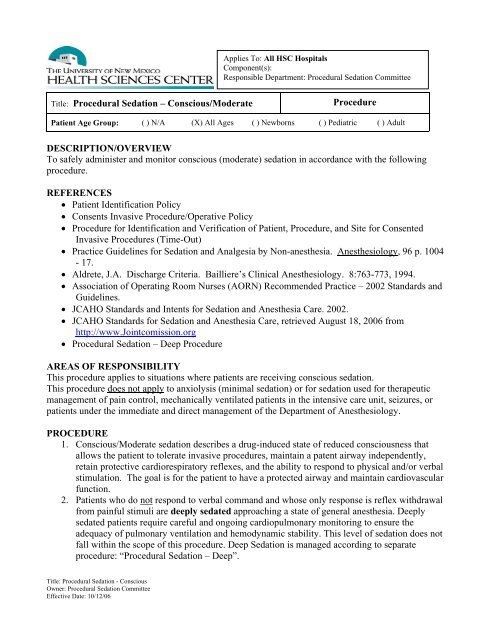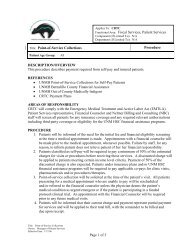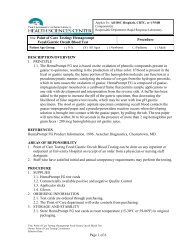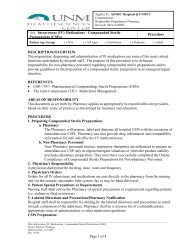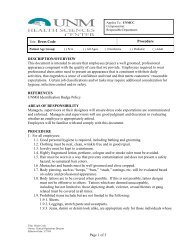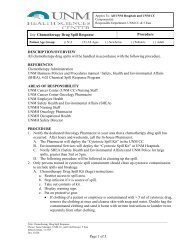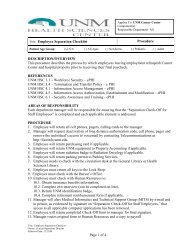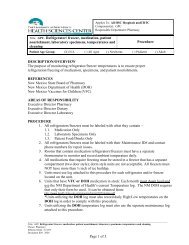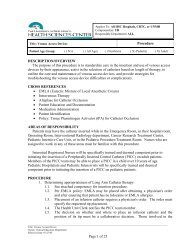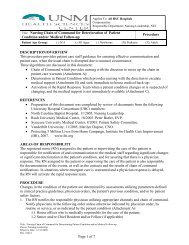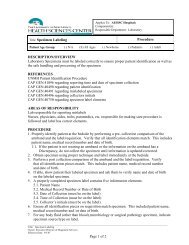(moderate) sedation in accordance with the following procedure.
(moderate) sedation in accordance with the following procedure.
(moderate) sedation in accordance with the following procedure.
Create successful ePaper yourself
Turn your PDF publications into a flip-book with our unique Google optimized e-Paper software.
Applies To: All HSC Hospitals<br />
Component(s):<br />
Responsible Department: Procedural Sedation Committee<br />
Title: Procedural Sedation – Conscious/Moderate<br />
Procedure<br />
Patient Age Group: ( ) N/A (X) All Ages ( ) Newborns ( ) Pediatric ( ) Adult<br />
DESCRIPTION/OVERVIEW<br />
To safely adm<strong>in</strong>ister and monitor conscious (<strong>moderate</strong>) <strong>sedation</strong> <strong>in</strong> <strong>accordance</strong> <strong>with</strong> <strong>the</strong> follow<strong>in</strong>g<br />
<strong>procedure</strong>.<br />
REFERENCES<br />
• Patient Identification Policy<br />
• Consents Invasive Procedure/Operative Policy<br />
• Procedure for Identification and Verification of Patient, Procedure, and Site for Consented<br />
Invasive Procedures (Time-Out)<br />
• Practice Guidel<strong>in</strong>es for Sedation and Analgesia by Non-anes<strong>the</strong>sia. Anes<strong>the</strong>siology, 96 p. 1004<br />
- 17.<br />
• Aldrete, J.A. Discharge Criteria. Bailliere’s Cl<strong>in</strong>ical Anes<strong>the</strong>siology. 8:763-773, 1994.<br />
• Association of Operat<strong>in</strong>g Room Nurses (AORN) Recommended Practice – 2002 Standards and<br />
Guidel<strong>in</strong>es.<br />
• JCAHO Standards and Intents for Sedation and Anes<strong>the</strong>sia Care. 2002.<br />
• JCAHO Standards for Sedation and Anes<strong>the</strong>sia Care, retrieved August 18, 2006 from<br />
http://www.Jo<strong>in</strong>tcomission.org<br />
• Procedural Sedation – Deep Procedure<br />
AREAS OF RESPONSIBILITY<br />
This <strong>procedure</strong> applies to situations where patients are receiv<strong>in</strong>g conscious <strong>sedation</strong>.<br />
This <strong>procedure</strong> does not apply to anxiolysis (m<strong>in</strong>imal <strong>sedation</strong>) or for <strong>sedation</strong> used for <strong>the</strong>rapeutic<br />
management of pa<strong>in</strong> control, mechanically ventilated patients <strong>in</strong> <strong>the</strong> <strong>in</strong>tensive care unit, seizures, or<br />
patients under <strong>the</strong> immediate and direct management of <strong>the</strong> Department of Anes<strong>the</strong>siology.<br />
PROCEDURE<br />
1. Conscious/Moderate <strong>sedation</strong> describes a drug-<strong>in</strong>duced state of reduced consciousness that<br />
allows <strong>the</strong> patient to tolerate <strong>in</strong>vasive <strong>procedure</strong>s, ma<strong>in</strong>ta<strong>in</strong> a patent airway <strong>in</strong>dependently,<br />
reta<strong>in</strong> protective cardiorespiratory reflexes, and <strong>the</strong> ability to respond to physical and/or verbal<br />
stimulation. The goal is for <strong>the</strong> patient to have a protected airway and ma<strong>in</strong>ta<strong>in</strong> cardiovascular<br />
function.<br />
2. Patients who do not respond to verbal command and whose only response is reflex <strong>with</strong>drawal<br />
from pa<strong>in</strong>ful stimuli are deeply sedated approach<strong>in</strong>g a state of general anes<strong>the</strong>sia. Deeply<br />
sedated patients require careful and ongo<strong>in</strong>g cardiopulmonary monitor<strong>in</strong>g to ensure <strong>the</strong><br />
adequacy of pulmonary ventilation and hemodynamic stability. This level of <strong>sedation</strong> does not<br />
fall <strong>with</strong><strong>in</strong> <strong>the</strong> scope of this <strong>procedure</strong>. Deep Sedation is managed accord<strong>in</strong>g to separate<br />
<strong>procedure</strong>: “Procedural Sedation – Deep”.<br />
Title: Procedural Sedation - Conscious<br />
Owner: Procedural Sedation Committee<br />
Effective Date: 10/12/06
3. Informed consent for <strong>the</strong> <strong>procedure</strong> and <strong>moderate</strong>/conscious <strong>sedation</strong> must be obta<strong>in</strong>ed<br />
prior to <strong>the</strong> <strong>in</strong>itiation of <strong>moderate</strong>/conscious <strong>sedation</strong> accord<strong>in</strong>g to <strong>the</strong> “Consents Invasive<br />
Procedure/Operative Policy”. This is accomplished after <strong>the</strong> practitioner has performed <strong>the</strong><br />
History and Physical (H&P) and is able to complete a Risk/Benefit analysis. Consent = Timeout<br />
requirement.<br />
4. Only RNs, GNs under supervision, Specialty Registered Respiratory Therapists <strong>with</strong> <strong>the</strong>ir<br />
expanded scope of practice, mid-level providers or physicians may adm<strong>in</strong>ister <strong>moderate</strong>/<br />
conscious <strong>sedation</strong> medication provided <strong>the</strong>y have current age-appropriate ALS certification<br />
and demonstrated <strong>moderate</strong> /conscious <strong>sedation</strong> competency.<br />
5. LPN’s may adm<strong>in</strong>ister PO/PR Chloral Hydrate and provide monitor<strong>in</strong>g for those patients,<br />
provided <strong>the</strong>y have current age-appropriate ALS certification and demonstrated <strong>moderate</strong><br />
/conscious <strong>sedation</strong> competency via <strong>the</strong> class or module and complete <strong>the</strong> annual on-l<strong>in</strong>e<br />
competency.<br />
6. The above mentioned qualified personnel manag<strong>in</strong>g <strong>the</strong> procedural care of <strong>the</strong> patient receiv<strong>in</strong>g<br />
<strong>moderate</strong>/conscious <strong>sedation</strong> should have no o<strong>the</strong>r responsibilities that would require leav<strong>in</strong>g<br />
<strong>the</strong> patient unattended or compromis<strong>in</strong>g cont<strong>in</strong>uous patient monitor<strong>in</strong>g dur<strong>in</strong>g <strong>the</strong> <strong>procedure</strong>.<br />
The qualified personnel adm<strong>in</strong>ister<strong>in</strong>g <strong>moderate</strong>/conscious <strong>sedation</strong> will report off to <strong>the</strong><br />
accept<strong>in</strong>g staff all of <strong>the</strong>ir patient care responsibilities for <strong>the</strong> duration of <strong>the</strong> <strong>procedure</strong> and<br />
recovery.<br />
7. In <strong>the</strong> follow<strong>in</strong>g situations, <strong>the</strong> physician should consider consultation <strong>with</strong> an anes<strong>the</strong>siologist<br />
prior to <strong>sedation</strong>:<br />
a. Patient does not fulfill NPO criteria and requires emergency diagnostic exam or<br />
<strong>procedure</strong>.<br />
b. Severe cardiopulmonary, neurological or o<strong>the</strong>r organ system disease, which may present<br />
a significant hazard <strong>with</strong> <strong>the</strong> adm<strong>in</strong>istration of <strong>sedation</strong>.<br />
c. Potential difficult airway management (i.e. distorted anatomy, obstructive sleep apnea,<br />
morbid obesity, micrognathia, immobilization of <strong>the</strong> head and neck).<br />
d. Patient tak<strong>in</strong>g medication that may adversely react <strong>with</strong> sedatives or analgesics (i.e.<br />
MAO <strong>in</strong>hibitors).<br />
e. Prior history of adverse reaction to <strong>sedation</strong> or anes<strong>the</strong>sia.<br />
8. Patients who score as an American Society of Anes<strong>the</strong>siology: Physical Status (ASA: PS) class<br />
4, 5 or E are not appropriate candidates for <strong>moderate</strong>/ conscious <strong>sedation</strong>.<br />
9. Patients who receive <strong>moderate</strong>/conscious <strong>sedation</strong> and require transfer off <strong>the</strong> floor for<br />
<strong>procedure</strong>s must be accompanied by appropriately tra<strong>in</strong>ed staff.<br />
EQUIPMENT (essential):All <strong>moderate</strong>/conscious <strong>sedation</strong> patients will be monitored <strong>with</strong> <strong>the</strong><br />
follow<strong>in</strong>g equipment:<br />
1. Non-<strong>in</strong>vasive blood pressure monitor<br />
2. Pulse oximetry<br />
3. Oxygen capability<br />
4. Suction capability<br />
5. Crash cart <strong>with</strong> age and size appropriate equipment is available on <strong>the</strong> unit/department where<br />
<strong>sedation</strong> is given.<br />
6. IV access (see age specific for pediatric exclusions)<br />
7. Reversal drugs, such as; Naloxone (Narcan), Flumazenil (Romazicon), Atrop<strong>in</strong>e<br />
8. Electrocardiographic monitor <strong>with</strong> defibrillator capability is required for all patients <strong>with</strong><br />
Title: Procedural Sedation - Conscious<br />
Owner: Procedural Sedation Committee<br />
Effective Date: 10/12/06
an ASA/PS score of 3 or higher. See Attachment A<br />
PROCEDURE DETAIL:<br />
1. Assessment, plann<strong>in</strong>g, implementation and evaluation of care for a patient undergo<strong>in</strong>g<br />
<strong>moderate</strong>/conscious <strong>sedation</strong>.<br />
1.1 Assessment<br />
1.1.1 Pre-<strong>procedure</strong> history<br />
1.1.2. Major organ systems<br />
1.1.3. Alcohol, tobacco, illicit substance use<br />
1.1.4. Drug allergies<br />
1.1.5. Previous experience <strong>with</strong> <strong>sedation</strong>/analgesia or anes<strong>the</strong>sia<br />
1.1.6. Current medications <strong>in</strong>clud<strong>in</strong>g over-<strong>the</strong>-counter medications or homeopathic<br />
remedies<br />
1.1.7. Availability of a ride home for outpatient <strong>procedure</strong>s<br />
1.1.8. Physician’s order for NPO status<br />
1.1.9. Verification of NPO status<br />
Gastric empty<strong>in</strong>g may be <strong>in</strong>fluenced by many factors <strong>in</strong>clud<strong>in</strong>g anxiety, pa<strong>in</strong>, abnormal autonomic<br />
function (i.e. diabetes), pregnancy and mechanical obstruction. Therefore, <strong>the</strong> suggestions listed<br />
do not guarantee that complete gastric empty<strong>in</strong>g has occurred. Unless contra<strong>in</strong>dicated, pediatric<br />
patients should be offered clear liquids until 2-3 hours before <strong>sedation</strong> to m<strong>in</strong>imize <strong>the</strong> risk of<br />
dehydration.<br />
N P O GUIDELINES<br />
Age Classification *Solids or Nonclear Liquids Clear Liquids<br />
Adults 6 – 8 Hours or none after midnight 2 – 3 Hours<br />
Children > 36 months 6 – 8 Hours 2 – 3 Hours<br />
Children aged 6 – 36 months 6 Hours 2 – 3 Hours<br />
Children < 6 months 4 – 6 Hours 2 Hours<br />
*This <strong>in</strong>cludes milk, formula and breast milk (high fat content may delay gastric empty<strong>in</strong>g)<br />
1.2. Focal Physical Assessment<br />
1.2.1. Consciousness level<br />
1.2.2. Basel<strong>in</strong>e vital signs (heart rate, respiratory rate, blood pressure, oxygen<br />
saturation). Weight and age of patient.<br />
1.2.3. Respiratory/airway assessment<br />
1.2.4. Cardiovascular assessment<br />
1.3. Pre-Sedation scor<strong>in</strong>g us<strong>in</strong>g <strong>the</strong> assessment ASA/PS guidel<strong>in</strong>es (See Attachment A).<br />
ASA/PS scor<strong>in</strong>g shall be done by a physician or by a qualified licensed <strong>in</strong>dividual <strong>in</strong><br />
conjunction <strong>with</strong> <strong>the</strong> physician.<br />
2. Plann<strong>in</strong>g<br />
2.1 Expla<strong>in</strong> <strong>the</strong> steps to <strong>the</strong> patient, family or significant o<strong>the</strong>rs prior to <strong>the</strong> <strong>in</strong>itiation<br />
of <strong>moderate</strong>/conscious <strong>sedation</strong>.<br />
2.2 Prepare pharmacological agents accord<strong>in</strong>g to physician’s order us<strong>in</strong>g weight based<br />
dosage formula below as a guidel<strong>in</strong>e, if appropriate.<br />
Title: Procedural Sedation - Conscious<br />
Owner: Procedural Sedation Committee<br />
Effective Date: 10/12/06
2.3 Have reversal agents immediately available.<br />
2.4 Consent = Time-out requirement<br />
-Correct patient<br />
-Correct Side & Site<br />
-Agreement on Procedure be<strong>in</strong>g performed<br />
-Correct patient position<br />
-Availability of correct implants, equipment, labs and x-rays.<br />
-Entire team present.<br />
3. Implementation<br />
3.1 Monitor<strong>in</strong>g will be done by personnel that have demonstrated <strong>moderate</strong>/conscious<br />
<strong>sedation</strong> competency. The <strong>in</strong>dividual monitor<strong>in</strong>g shall NOT have additional duties or<br />
responsibilities.<br />
3.1.1. Neurological<br />
3.1.1.1. Level of consciousness (LOC) should be assessed every 1 to 2<br />
m<strong>in</strong>utes dur<strong>in</strong>g <strong>the</strong> onset of <strong>sedation</strong> and whenever medications are<br />
be<strong>in</strong>g titrated.<br />
3.1.1.2. Assess for oral, thumbs-up or eye open<strong>in</strong>g response to verbal or light<br />
tactile stimulation.<br />
3.1.2. Respiratory<br />
3.1.2.1. Observation of respirations, chest movement, color and auscultation<br />
of breath sounds<br />
3.1.2.2. Cont<strong>in</strong>uous pulse oximetry<br />
3.1.2.3. Supplemental oxygen should be adm<strong>in</strong>istered as needed<br />
3.1.3 Cardiovascular<br />
3.1.3.1 Monitor heart rate and blood pressure every 1-2 m<strong>in</strong>utes dur<strong>in</strong>g onset<br />
of <strong>sedation</strong>.<br />
3.1.3.2 Monitor heart rate and blood pressure every 5 m<strong>in</strong>utes dur<strong>in</strong>g<br />
<strong>procedure</strong>.<br />
3.1.3.3 Cont<strong>in</strong>uous ECG monitor<strong>in</strong>g for patients <strong>with</strong> underly<strong>in</strong>g<br />
cardiovascular disease, <strong>procedure</strong>s <strong>with</strong> an <strong>in</strong>creased risk of<br />
dysrhythmia or patients who have a detected dysrhythmia per<br />
auscultation. This shall <strong>in</strong>clude all patients <strong>with</strong> ASA score 3 or<br />
greater. Crash carts serv<strong>in</strong>g multi-patient areas will not be used for<br />
elective <strong>procedure</strong>s. Moderate/Conscious Sedation carts will be<br />
used.<br />
4. Evaluation<br />
4.1 Recovery Care (Medical P&P)<br />
4.1.1 Patients must be monitored by personnel that have demonstrated<br />
<strong>moderate</strong>/conscious <strong>sedation</strong> competency to ensure that any adverse events are<br />
rapidly recognized and appropriately treated. The <strong>in</strong>dividual monitor<strong>in</strong>g<br />
recovery shall NOT have additional duties or responsibilities.<br />
4.1.2 Vital signs should be recorded at 10-15 m<strong>in</strong>ute <strong>in</strong>tervals and as needed until<br />
discharge criteria are met. Pulse oximetry should be cont<strong>in</strong>ued until <strong>the</strong> patient<br />
is no longer at risk for hypoxemia.<br />
4.1.3 If any reversal agents were used, <strong>the</strong> patient must be observed for two hours to<br />
Title: Procedural Sedation - Conscious<br />
Owner: Procedural Sedation Committee<br />
Effective Date: 10/12/06
ensure that respiratory depression does not recur.<br />
4.1.4 The patient must be monitored beyond <strong>the</strong> onset and peak effect of any<br />
<strong>moderate</strong>/conscious <strong>sedation</strong> medications.<br />
4.2. Discharge Criteria<br />
4.2.1 M<strong>in</strong>imum Aldrete Scale score of 8 or at basel<strong>in</strong>e if start<strong>in</strong>g lower (Attachment<br />
B)...<br />
4.2.2 Verbalized understand<strong>in</strong>g of discharge <strong>in</strong>structions by <strong>the</strong> patient or responsible<br />
adult. Procedure specific <strong>in</strong>structions should <strong>in</strong>clude emergency telephone<br />
numbers for any post-<strong>procedure</strong> complications.<br />
1. Pediatric patients who require consultation for <strong>moderate</strong>/conscious <strong>sedation</strong> may also<br />
consult Pediatric Critical Care <strong>in</strong> addition to Anes<strong>the</strong>siology.<br />
2. A pediatric code sheet <strong>with</strong> appropriate weight should be available.<br />
3. Children under <strong>the</strong> age of eight years may receive <strong>the</strong> follow<strong>in</strong>g ORAL medications<br />
<strong>with</strong>out IV access, if <strong>the</strong>y score as an ASA class I or II:<br />
• Chloral hydrate up to 100 mg/kg<br />
• Midazolam (Versed) up to 0.5 mg/kg<br />
4. Children under <strong>the</strong> age of eight years who are receiv<strong>in</strong>g ORAL Chloral hydrate or ORAL<br />
Versed (as above), may have Capillary Blood Refill substitute for Blood Pressure, if <strong>the</strong>y<br />
score as an ASA class I or II.<br />
SPECIAL SITUATIONS/PATIENT POPULATIONS<br />
1. Patients undergo<strong>in</strong>g <strong>procedure</strong>s where blood loss is a concern should have larger age<br />
appropriate IV placed. (i.e. 18 gauge for an adult)<br />
2. Burn and Wound patients are often medically complex as well as fac<strong>in</strong>g ongo<strong>in</strong>g pa<strong>in</strong>ful<br />
<strong>procedure</strong>s. New drug dos<strong>in</strong>g guidel<strong>in</strong>es may be required to adequately address <strong>the</strong><br />
patient’s pa<strong>in</strong> and anxiety dur<strong>in</strong>g <strong>moderate</strong>/conscious <strong>sedation</strong> <strong>procedure</strong>s. Additional<br />
consultation <strong>with</strong> <strong>the</strong> physician is required for orders for <strong>in</strong>creased doses of medication (i.e.<br />
Fentanyl 5-10 mcg/kg/m<strong>in</strong>ute, maximum dose for <strong>the</strong> <strong>procedure</strong> may approach 500 mcg).<br />
KEY DOCUMENTATION:<br />
1. All documentation will be done on <strong>the</strong> Moderate/Conscious Sedation Documentation<br />
Flow Sheet. Exception: Intubated patients <strong>in</strong> <strong>the</strong> ICU and OR. The Procedural Sedation<br />
Documentation Flow Sheet, (#10202- pages 1& 2, <strong>the</strong> ma<strong>in</strong> form) (#10202C- pages 3 &<br />
4, <strong>the</strong> ASA/ PS class three or greater and overflow form).<br />
See Forms Page under Cl<strong>in</strong>ical Forms for Sedation Flow Sheet.<br />
2.A copy of <strong>the</strong> <strong>procedure</strong> specific discharge <strong>in</strong>structions will be completed <strong>with</strong> <strong>the</strong><br />
patient, family or significant o<strong>the</strong>r.<br />
DEFINITIONS<br />
Moderate/conscious <strong>sedation</strong> describes a drug-<strong>in</strong>duced state of reduced consciousness that<br />
allows <strong>the</strong> patient to tolerate <strong>in</strong>vasive <strong>procedure</strong>s, ma<strong>in</strong>ta<strong>in</strong> a patent airway <strong>in</strong>dependently,<br />
reta<strong>in</strong> protective cardiorespiratory reflexes, and <strong>the</strong> ability to respond to physical and/or verbal<br />
stimulation. The goal is for <strong>the</strong> patient to have a protected airway and ma<strong>in</strong>ta<strong>in</strong> cardiovascular<br />
Title: Procedural Sedation - Conscious<br />
Owner: Procedural Sedation Committee<br />
Effective Date: 10/12/06
function.<br />
SUMMARY OF CHANGES<br />
There are no changes to <strong>the</strong> document s<strong>in</strong>ce <strong>the</strong> last version, o<strong>the</strong>r than format.<br />
KEY WORDS<br />
Sedation, Moderate Sedation, Conscious Sedation, Moderate Conscious Sedation, Procedural Sedation.<br />
RESOURCES/TRAINING:<br />
Procedural Sedation Course<br />
Difficult Airway Management Course<br />
Rapid Sequence Intubation Course<br />
See <strong>the</strong> BATCAVE catalogue for a complete list of offer<strong>in</strong>gs and resources.<br />
Resource/Dept<br />
Cl<strong>in</strong>ical Education<br />
BATCAVE<br />
Internet/L<strong>in</strong>k<br />
http://hyper.unm.edu/unmhs_<strong>in</strong>tranet/Education/CE_Page/CE_Staff.cfm<br />
DOCUMENT APPROVAL & TRACKING<br />
Item Contact Date Approval<br />
Owner<br />
Procedural Sedation Committee<br />
Steve McLaughl<strong>in</strong>, MD Emergency Medic<strong>in</strong>e<br />
Mark Crowley, MD Pediatric Intensivist<br />
Consultant(s)<br />
Michelle Moro, MD Pediatric Anes<strong>the</strong>sia<br />
Sheena Ferguson, MSN, RN Cl<strong>in</strong>ical Education<br />
Committee(s)<br />
Procedural Sedation Committee<br />
Cl<strong>in</strong>ical Operations Policy $ Procedure Committee<br />
Nurs<strong>in</strong>g Officer Judy Sp<strong>in</strong>ella [Y]<br />
Medical Director/Officer David Pitcher [Y]<br />
Human Resources [Name], HR Adm<strong>in</strong>istrator, [UNMH or UNM] [N/A]<br />
F<strong>in</strong>ance [Name, Title], [UNMH or HSC] [N/A]<br />
Legal [Name, Title], [UNMH or HSC] [N/A]<br />
Official Approver Judy L. Sp<strong>in</strong>ella, MBA, MSN, RN, Chief Nurs<strong>in</strong>g Officer<br />
Official Signature 10/12/06<br />
2 nd Approver (Optional)<br />
Signature<br />
[Day/Mo/Year]<br />
Effective Date 10/12/2006<br />
Orig<strong>in</strong>ation Date 7/1/2003<br />
Issue Date<br />
Cl<strong>in</strong>ical Operations Policy Coord<strong>in</strong>ator<br />
ATTACHMENTS:<br />
Attachment A – American Society of Anes<strong>the</strong>siology: Physical Status Classification<br />
Attachment B – Modified Aldrete Scor<strong>in</strong>g System<br />
Attention: Current Sedation Flow sheet Form is on-l<strong>in</strong>e via <strong>the</strong> forms page under Cl<strong>in</strong>ical Forms<br />
(2006 version).<br />
Y<br />
Title: Procedural Sedation - Conscious<br />
Owner: Procedural Sedation Committee<br />
Effective Date: 10/12/06
Attachment A – American Society of Anes<strong>the</strong>siology: Physical Status Classification<br />
American Society of Anes<strong>the</strong>siology: Physical Status Classification<br />
ASA<br />
Classification<br />
P I<br />
Medical Description of<br />
Patient<br />
No known systemic<br />
disease<br />
Comments<br />
Optimal Candidates for <strong>moderate</strong><br />
<strong>sedation</strong><br />
PII<br />
P III<br />
P IV<br />
Mild or well controlled<br />
systemic disease(s)<br />
Multiple or <strong>moderate</strong><br />
controlled systemic<br />
disease(s)<br />
Poorly controlled systemic<br />
disease(s)<br />
Medical Consultation is highly<br />
recommended.<br />
P V<br />
Moribund Patient<br />
Anes<strong>the</strong>sia provider is required*.<br />
PVI<br />
Declared Bra<strong>in</strong> Dead<br />
patient/ Organ Donor<br />
*Anes<strong>the</strong>sia provider may not be required or available <strong>in</strong> an emergency.<br />
Title: Procedural Sedation - Conscious<br />
Owner: Procedural Sedation Committee<br />
Effective Date: 10/12/06
Attachment B – Aldrete Scor<strong>in</strong>g System<br />
Modified Aldrete Scor<strong>in</strong>g System<br />
Able to move four extremities voluntarily on command 2<br />
ACTIVITY<br />
Able to move two extremities voluntarily on command 1<br />
Unable to move 0<br />
Able to deep brea<strong>the</strong> and cough freely 2<br />
RESPIRATION<br />
Dyspnea or limited breath<strong>in</strong>g 1<br />
Apneic 0<br />
BP and HR ± 20% of preanes<strong>the</strong>tic level 2<br />
CIRCULATION<br />
BP and HR ± 20% to 50 % of preanes<strong>the</strong>tic level 1<br />
BP and HR ± 50% of preanes<strong>the</strong>tic level 0<br />
Fully Awake (able to answer questions) 2<br />
CONSCIOUSNESS<br />
Arousable on call<strong>in</strong>g (arousable only to call<strong>in</strong>g) 1<br />
Unresponsive 0<br />
Able to ma<strong>in</strong>ta<strong>in</strong> O 2 saturation > 92% on room air 2<br />
OXYGENATION<br />
Needs O 2 <strong>in</strong>halation to ma<strong>in</strong>ta<strong>in</strong> saturation > 90% 1<br />
O 2 saturation < 90%, even <strong>with</strong> O 2 supplement 0<br />
_________________________________________________________________________________________________________________<br />
Title: Procedural Sedation - Conscious<br />
Owner: Procedural Sedation Committee<br />
Effective Date: 8/2/2006<br />
Page 8 of 8


